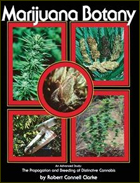
by Robert Connell Clarke
Seed Selection
Nearly every cultivated Cannabis plant, no matter what its future, began as a germinating seed; and nearly all Cannabis cultivators, no matter what their intention, start with seeds that are gifts from a fellow cultivator or extracted from imported shipments of marijuana. Very little true control can be exercised in seed selection unless the cultivator travels to select growing plants with favorable characteristics and personally pollinate them. This is not possible for most cultivators or researchers and they usually rely on imported seeds. These seeds are of unknown parentage, the product of natural selection or of breeding by the original farmer, Certain basic problems affect the genetic purity and predictability of collected seed.
1 – If a Cannabis sample is heavily seeded, then the majority of the male plants were allowed to mature and release pollen, Since Cannabis is wind-pollinated, many pollen parents (including early and late maturing staminate and hermaphrodite plants) will contribute to the seeds in any batch of pistillate flowers. If the seeds are all taken from one flower cluster with favorable characteristics, then at least the pistillate or seed parent is the same for all those seeds, though the pollen may have come from many different parents. This creates great diversity in offspring.
2 – In very lightly seeded or nearly sinsemilla Cannabis, pollination has largely been prevented by the removal of staminate parents prior to the release of pollen. The few seeds that do form often result from pollen from hermaphrodite plants that went undetected by the farmer, or by random wind-borne pollen from wild plants or a nearby field. Hermaphrodite parents often produce hermaphrodite offspring and this may not be desirable.
3 – Most domestic Cannabis strains are random hybrids. This is the result of limited selection of pollen parents, impure breeding conditions, and lack of adequate space to isolate pollen parents from the remainder of the crop.
When selecting seeds, the propagator will frequently look for seed plants that have been carefully bred locally by another propagator. Even if they are hybrids there is a better chance of success than with imported seeds, provided certain guidelines are followed:
1 – The dried seeded flower clusters are free of staminate flowers that might have caused hermaphrodite pollinations.
2 – The flowering clusters are tested for desirable traits and seeds selected from the best.
3 – Healthy, robust seeds are selected. Large, dark seeds are best; smaller, paler seeds are avoided since these are usually less mature and less viable.
4 – If accurate information is not available about the pollen parent, then selection proceeds on common sense and luck. Mature seeds with dried calyxes in the basal portions of the floral clusters along the main stems occur in the earliest pistillate flowers to appear and must have been pollinated by early-maturing pollen parents. These seeds have a high chance of producing early-maturing offspring. By contrast, mature seeds selected from the tips of floral clusters, often surrounded by immature seeds, are formed in later-appearing pistillate flowers. These flowers were likely pollinated by later-maturing staminate or hermaphrodite pollen parents, and their seeds should mature later and have a greater chance of producing hermaphrodite offspring. The pollen parent also exerts some influence on the appearance of the resulting seed. If seeds are collected from the same part of a flower cluster and selected for similar size, shape, color, and perianth patterns, then it is more likely that the pollinations represent fewer different gene pools and will produce more uniform offspring.
5 – Seeds are collected from strains that best suit the locality; these usually come from similar climates and latitudes. Seed selection for specific traits is discussed in detail in Chapter III.
6 – Pure strain seeds are selected from crosses between parents of the same origin.
7 – Hybrid seeds are selected from crosses between pure strain parents of different origins.
8 – Seeds from hybrid plants, or seeds resulting from pollination by hybrid plants, are avoided, since these will not reliably reproduce the phenotype of either parent. Seed stocks are graded by the amount of control exerted by the collector in selecting the parents.
Grade #1 – Seed parent and pollen parent are known and there is absolutely no possibility that the seeds resulted from pollen contamination.
Grade #2 – Seed parent is known but several known staminate or hemaphrodite pollen parents are involved.
Grade #3 – Pistillate parent is known and pollen parents are unknown.
Grade #4 – Neither parent is known, but the seeds are collected from one floral cluster, so the pistillate seed parentage traits may be characterized.
Grade #5 – Parentage is unknown but origin is certain, such as seeds collected from the bottom of a bag of imported Cannabis.
Grade #6 – Parentage and origin are unknown.

